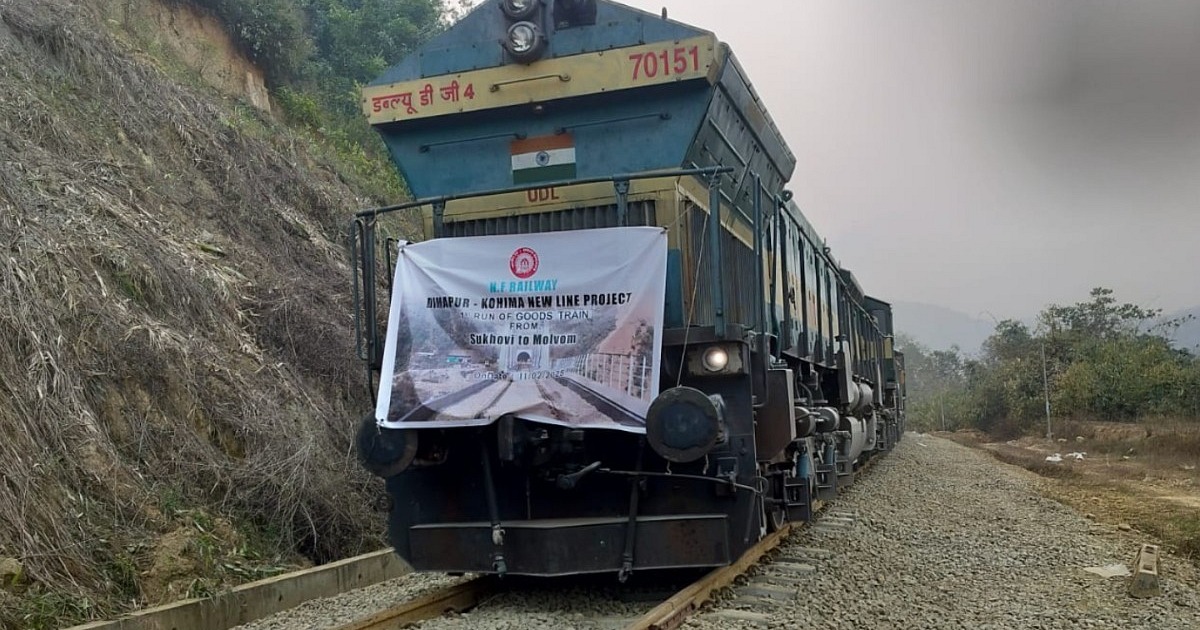
Kohima set to join India’s rail network with new Shokhuvi-Molvom line
GUWAHATI : In a significant step toward bridging connectivity gaps in Northeast India by the Narendra Modi Government, the Commissioner of Railway Safety (CRS), Sumeet Singhal, has greenlit train operations on the newly constructed 14.64-kilometer Shokhuvi-Molvom broad gauge (BG) railway section in Nagaland. The authorization, granted on March 27 and 28, 2025, follows a meticulous statutory inspection of the line, which forms a crucial segment of the ambitious 82.50-kilometer Dimapur-Kohima Railway Project.
The Dimapur-Kohima rail line, stretching from Dhansiri station in Assam to Zubza in Kohima, Nagaland, spans 2.75 kilometers in Assam and 79.75 kilometers in Nagaland. Once fully operational, it promises to integrate the state capital of Nagaland with the rest of the country, boosting economic growth, tourism, and accessibility. The project features eight new stations—Dhansiri, Dhansiripar, Shokhuvi, Molvom, Pherima, Piphema, Menguzuma, and Zubza—along with an impressive engineering feat: 27 major bridges, 149 minor bridges, five road overbridges, 15 road underbridges, and 20 tunnels totaling 31 kilometers in length.
The Shokhuvi-Molvom section marks the latest milestone in this transformative infrastructure endeavor. A 16.5-kilometer stretch from Dhansiri to Shokhuvi was commissioned in October 2021, enabling passenger train services from Shokhuvi to Naharlagun in Arunachal Pradesh and Mendipathar in Meghalaya. With the CRS’s approval, trains can now operate on the Shokhuvi-Molvom section at a maximum speed of 90 kilometers per hour, following successful inspections and speed trials.
During the inspection, Singhal was joined by key officials from Northeast Frontier Railway (NFR), including Anjani Kumar, Chief Administrative Officer (Construction-2), Ashutosh Kumar Mishra, Chief Engineer (Construction) for the Nagaland Project, and Vikas Singh, Deputy Chief Engineer (Construction) based in Dimapur. Their leadership has been instrumental in driving the project’s progress.
A Gateway to growth
The newly laid Shokhuvi-Molvom line is poised to unlock a wealth of opportunities for Nagaland. Enhanced rail connectivity is expected to facilitate the movement of freight and passengers, fostering the growth of small-scale industries and invigorating the state’s tourism sector. For a hilly region long challenged by logistical constraints, the railway promises to slash transportation costs for goods and materials, ensuring a steady supply of essentials and significantly reducing travel times.
“This is a game-changer for Nagaland,” said a local official, speaking on condition of anonymity. “The rail link will not only connect us to neighboring states but also provide long-distance access across India. It’s a lifeline for our economy and our people.”
The Dimapur-Kohima rail project is part of a broader push to expand railway infrastructure across Northeast India, a region historically underserved by such networks. With monumental projects underway, experts predict a paradigm shift in trade and commerce by 2030, positioning the Northeast as a key player in India’s economic landscape.
Connecting the Northeast
The completion of the Shokhuvi-Molvom section brings Nagaland closer to realizing the full potential of the Dimapur-Kohima line. Once the entire 82.50-kilometer stretch is operational, residents of the state capital and surrounding areas will enjoy seamless connectivity with Assam and beyond. The project’s scale—spanning tunnels, bridges, and rugged terrain—underscores the engineering prowess and determination driving this initiative.
For now, the focus remains on completing the remaining sections, with railway officials optimistic about meeting future deadlines. As Northeast India’s rail network continues its rapid expansion, the Shokhuvi-Molvom line stands as a testament to the region’s evolving infrastructure and its promise of a more connected, prosperous future.
